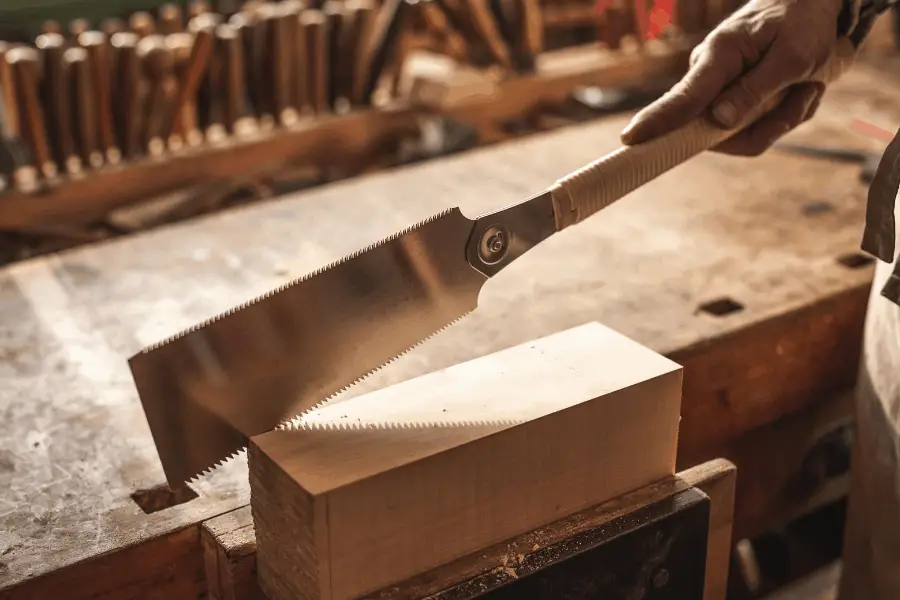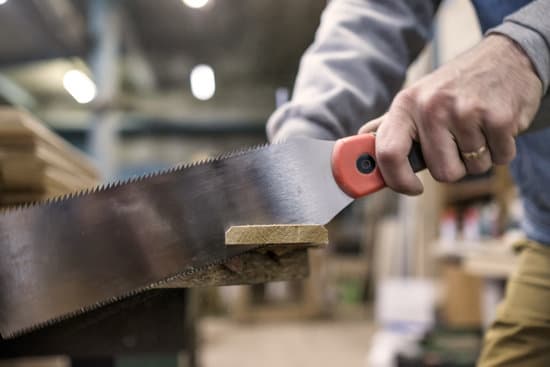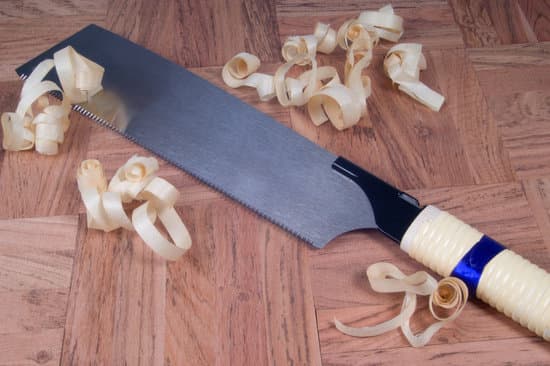
A Japanese Pull Saw is a handsaw developed in Japan that is thinner than a traditional western push saw and cuts on the pull stroke which keeps the cut straigher.
There are so many helpful options when it comes to saws for your project. Each tool has a specific purpose and function that separates it from the others. I’ve researched through the internet and put together a quick summary on the Japanese Pull Saw.
What is a Japanese pull saw used for? The Japanese Pull Saw is a very sharp thin flexible handsaw developed in Japan that cuts on the pull stroke of the blade. It is used to produce a finer cut, cutting notches, all types of joinery cuts, crosscuts, rip cuts, flush cuts, casings, moldings, cutting baseboards to fit tile under and cutting door jams.
Keep reading below to learn more about the Japanese Pull Saw and what it can be used for.
What Is a Japanese Pull Saw?
The Japanese Pull Saw, or Nokogiri (means handsaw), is a variety of saw used in woodworking and is of Japanese origin. Unlike most Western-made saws that were crafted to cut on the push stroke, the Japanese Pull Saw is specifically designed to cut on the pull-stroke, hence the name.
Japanese saws are the most popular version of the pull saws. These saws are thinner, sharper, easier to use and quicker for a lot of projects compared to power tools. Because of how sharp they are they will be more accurate creating less clean up on your joinery compared to western push handsaws. Some have fixed handles and some have folding blade handles.
The world of saws is wide and varied. There’s a saw for every job and every hand. Many saws work for various tasks, and so, in some cases, different saws are interchangeable, and use is based on preference. One such saw is the Japanese Pull Saw.
What Is A Japanese Pull Saw Used For?
The best aspect of the Japanese Saw is its versatility. These saws are flexible enough to be used to produce a finer cut, cutting notches, all types of joinery cuts, crosscuts, rip cuts, flush cuts, cutting baseboards to fit tile under and cutting door jams. Japanese Saws are great for making straight accurate cuts.
You don’t want to use one on plywood or MDF because it has a tendency to brake the teeth on the blade. they have an end tooth on both sides of the blade that is a non cutting tooth called a depth stop; it helps to square up delicate joinery cuts.
PRO TIP: The best way to know if you’re cutting straight into your piece is to look at the flat side of the blade and find the reflection of your wood. If the reflection is straight and looks as it should, then your blade will cut straight.
Depending on the task, Japanese Pull Saws work for any job that a typical Western handsaw is used for. To get your cut started, pull the teeth toward you, raking them across the surface of the wood at a downward angle. Then, push the teeth flat across the material surface, and then pull the teeth toward you. Take your time as you cut through the first quarter-inch of the wood. Once you get through the first quarter of an inch, your blade will be far enough into the wood to cut a straight line.
What Are The Different Types of Japanese Pull Saws?
Dozuki Saw
The Japanese name means “attached trunk/spine or Backsaw,” translates to a saw with a stiffening strip attached, to keep the blade from yielding or bending, i.e., a backsaw. It is paper thin and great for small shoulder cuts and dovetails. Easier to steer but limited on cut depth.

Ryoba Saw
Carpentry saw with two cutting edges. The Japanese name translates to “double blade.” One edge is a crosscut blade, and the reverse is a ripping blade. The blade is actually thinner in the middle of the blade than the outside to prevent them from binding in the wood during the cut. This is basically two saws in one.

Kataba Saw
A saw with a single toothed cutting edge, like a Western saw. Used as either a rip saw or cross-cut type blades. An advantage of this saw is that it can be easily paired with a fence to great effect. This one is a little thicker than other Japanese pull saws.

Azebiki Saw
A small ryōba saw used for cutting into the flat surface of a board rather than its edge. The blade has a convex curve and is similar to a veneer saw.

Mawashibiki Saw
This is the Japanese version of a keyhole saw with a thin blade designed for cutting curves. The name translates to “turning cut.”

Japanese Pull Saws are hand-powered saws designed to cut with a pulling action. They can be used for crosscuts or rip cuts. Japanese Saws come in various shapes and sizes for the different jobs that may arise. Their flexible blades make them versatile enough to help you achieve the multitude of cuts you may need.
What Is A Kataba Saw Used For?
The Kataba saw is a Japanese pull handsaw used for cross cuts and rip cuts. It has a single sided thin blade that cuts on the pull stroke help allows it to cut extremely accurate and straight cuts. It can be used for cutting quick and efficient joinery on small projects with limited cuts instead of setting up a jig on a power tool to make the cuts.
How Do You Cut A Japanese Saw Straight?
In order to cut a Japanese saw straight start your cut with the handle down compared to having the handle up with a traditional handsaw. This will pull the teeth into the grain making it easier to start the cut. Place your thumb near your start line like a fence and make one pull stroke with the saw, blow off the saw dust and make another stroke and blow off the dust each time until you have a nice accurate starting point. Grab the saw handle with both hands and make slow back and forth strokes until you have reached your full cut depth.
One trick to make sure your cut is accurate is to look at the reflection of the wood in the blade to make sure it’s square. If it starts to look off then your cut will be moving off track just stop and make the correct adjustment.
Subscribe to Jonathan Katz-Moses on Youtube
How Do You Change A Japanese Saw Blade?
Here is how you change the saw blade on various Japanese Saw styles:
Hook Style Japanese Saw:
Grab the blade with a glove or rag and hit the handle on your work bench. It will pivot and you will be able to remove the blade. Insert the replacement blade into the handle as far as you can by hand and you can tap the handle on your work bench if needed.
Screw Style Japanese Saw:
Use a flat head screw driver to remove the screw. Lift the blade out of the handle then slide in the new blade until its in place and replace the screw securely.
Traditional Wedge Style Japanese Saw:
Grab the blade with a rag and tap the handle with a hammer to slowly remove the blade. To add the new blade insert it into the handle then flip up-side down to tap the bottom of the handle to secure the blade in place.
Subscribe to Bob’s Wood Stuff on Youtube
How Do You Use A Japanese Pull Saw?
In order to use a Japanese Pull Saw start your cut with the handle down compared to having the handle up with a traditional handsaw. This will pull the teeth into the grain making it easier to start the cut. Place your thumb near your start line like a fence and make one pull stroke with the saw, blow off the saw dust and make another stroke and blow off the dust each time until you have a nice accurate starting point. Grab the saw handle with both hands and make slow back and forth strokes until you have reached your full cut depth.
One trick to make sure your cut is accurate is to look at the reflection of the wood in the blade to make sure it’s square. If it starts to look off then your cut will be moving off track just stop and make the correct adjustment.
Subscribe to finehomebuilding on Youtube
Best Japanese Pull Saws
Can You Sharpen Japanese Saws?
You can sharpen Japanese saws but it requires you to either find someone with the right skill and tools or ship the saw back to Japan for sharpening then ship it back to you. The quickest and most affordable option would be to just replace the blade.
Japanese Pull Saw Replacement Blades:
What Is A Pullsaw?
A Pullsaw is a handsaw that cuts on the pull stroke instead of the push stroke like a traditional western handsaw. The pullsaw can make straighter more accurate cuts because the blade is thinner and has better control. It is best used for fine joinery cuts, but can be used for cutting casing, trim, and molding. Japanese pull saws are the most commonly used pull saws and they come in a variety of options.
What Does Dozuki Mean?
Dozuki means “attached trunk/spine or Backsaw,” translates to a saw with a stiffening strip attached, to keep the blade from yielding or bending, i.e., a backsaw. It is paper thin and great for small shoulder cuts and dovetails. Easier to steer but limited on cut depth.
What Is The Difference Between A Rip Cut And A Cross Cut?
The difference between a rip cut and a cross cut is the direction of the grain in the wood is traveling compared to the direction you are cutting. When you are cross cutting you are cutting across the wood’s grain and when you are rip cutting you are cutting along the wood’s grain.
Cross cut blades have more teeth per inch on the blade because it is harder to cut against the grain fibers and rip cut blades have less teeth per inch because it is easier to cut along the fibers of the wood grain.
Which Japanese Saw To Buy?
The best Japanese Saw to buy would be a Ryoba style because it is basically two saws in one. It has teeth on each side of the blade. One side has a higher tooth count per inch for cross cutting and the other has fewer teeth per inch for rip cutting. If you have the budget it would be best to buy a Japanese saw set that comes with other options including a backsaw style called Dozuki and a single blade style called Kataba.
How Do You Use A Dozuki saw?
In order to cut using a Dozuki Japanese saw start your cut with the handle down compared to having the handle up with a traditional handsaw. This will pull the teeth into the grain making it easier to start the cut. Place your thumb near your start line like a fence and make one pull stroke with the saw, blow off the saw dust and make another stroke and blow off the dust each time until you have a nice accurate starting point. Grab the saw handle with both hands and make slow back and forth strokes until you have reached your full cut depth.
One trick to make sure your cut is accurate is to look at the reflection of the wood in the blade to make sure it’s square. If it starts to look off then your cut will be moving off track just stop and make the correct adjustment.
Guide To Japanese Pull Saws:
Subscribe to WoodWorkWeb on Youtube
The most common handsaw in western countries are push saws. They come in 2 varieties; the crosscut saw (cuts across the grain of wood and have more teeth per inch) and ripping saw (cuts along the grain of the wood and has less teeth per inch). Double sided Japanese Pull Saws have both a crosscut blade and a ripping cut blade.
Some come with a support part on top of the blade and this would be because the blade is even thinner than a traditional Japanese pull saw which are great for joinery cuts.
Should You Get A Japanese Pull Saw?
After most people learn about or try a Japanese pull saw they typically decide to get one. It can be thinner because it cuts on the pull stroke which keeps the blade straight as opposed to a push saw that needs to be thicker in order to remain straight during the cut.
The pull technique should be more healthy and ergonomic for your body because it requires more body parts to initiate the cutting motion compared to a push saw which you typically just use one arm for the cutting motion.
The Japanese pull saw is extremely accurate so any variation in your cut angle can lead to your cut veering off your cut line. Start your cut with the fine crosscut teeth to get the best starting position then flip over if your rip cutting.
You will need to get used to the pull saw cut technique to make sure you keep your cut in line because it uses your arms, shoulders, back, core and even legs.
Subscribe to Rex Krueger on Youtube
How To Make A Japanese Pull Saw.
It is going to be easier to buy a Japanese Pull Saw than making one but if you like making saws and getting creative here is a video show how to make a Japanese Pull Saw.
Subscribe to pyrotech1999 on Youtube
Pull Saw Vs. Push Saw.
Japanese Pull Saw:
- Some have 2 blades in one including a cross cut blade and rip cut blade.
- Cuts with the pull stroke.
- More ergonomic and healthier for your body because you use more muscle groups for the cutting motion.
- Thinner blade
- Blade teeth are hardened at the factory.
- Doesn’t need sharpening after purchase it is ready out of the box.
- Can’t sharpen on your own it is better to replace the blade.
Western Push Saw:
- Cuts with the push stroke
- Typically use single arm force to make your cut.
- Thicker blade.
- Blade teeth aren’t hardened at the factory.
- May need to sharpen after purchase.
PULL SAW VS. PUSH SAW
Subscribe to WoodWorkers Guild Of America on Youtube
